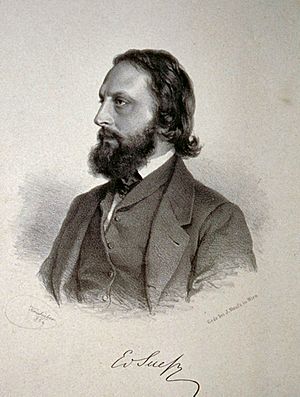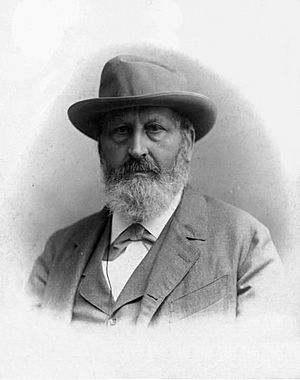Eduard Suess facts for kids
Quick facts for kids
Eduard Suess
|
|
|---|---|

Eduard Suess, 1869
|
|
| Born | 20 August 1831 London, England
|
| Died | 26 April 1914 (aged 82) Vienna, Austria
|
| Resting place | Marz, Austria |
| Nationality | Austrian |
| Alma mater | University of Vienna |
| Known for | Biosphere, Gondwana, Tethys Ocean, Das Antlitz der Erde, Eustatic Theory, Sima, sial |
| Spouse(s) | Hermine née Strauss |
| Children | 5 sons, 1 daughter |
| Awards | Hayden Memorial Geological Award (1892) Wollaston Medal (1896) Copley Medal (1903) |
| Scientific career | |
| Fields | Palaeogeography, tectonics |
| Doctoral students | Melchior Neumayr Johann August Georg Edmund Mojsisovics von Mojsvar Fuchs Wilhelm Heinrich Waagen Albrecht Penck |
| Influenced | Jovan Cvijić |
Eduard Suess (German: [ˈeːduaʁt zyːs]; 20 August 1831 - 26 April 1914) was an Austrian geologist and an expert on the geography of the Alps. He is responsible for hypothesising two major former geographical features, the supercontinent Gondwana (proposed in 1861) and the Tethys Ocean.
Contents
Biography
Eduard Suess was born on 20 August 1831 in London, England, the oldest son of Adolph Heinrich Suess, a Lutheran Saxon merchant, and mother Eleonore Friederike Zdekauer. Adolph Heinrich Suess was born on 11 March 1797 in Saxony, Holy Roman Empire and died on 24 May 1862 in Vienna, Austrian Empire, German confederation; Eleonore Friederike Zdekauer was born in Prague, nowadays part of the Czech Republic, which once belonged to the Holy Roman Empire and the Austrian Empire.
When Eduard Suess was born, his family relocated to Prague, and then to Vienna when he was 14. He became interested in geology at a young age. While working as an assistant at the Hofmuseum in Vienna, he published his first paper—on the geology of Carlsbad (in present-day Czech Republic)—when he was 19. In 1855, Suess married Hermine Strauss, the daughter of a prominent physician from Prague. Their marriage produced five sons and one daughter.
In 1856, he was appointed professor of paleontology at the University of Vienna, and in 1861 was appointed professor of geology. He gradually developed views on the connection between Africa and Europe. Eventually, he concluded that the Alps to the north were once at the bottom of an ocean, of which the Mediterranean was a remnant. Suess was not correct in his analysis, which was predicated upon the notion of "contractionism"—the idea that the Earth is cooling down and, therefore, contracting. Nevertheless, he is credited with postulating the earlier existence of the Tethys Ocean, which he named in 1893. He claimed in 1885 that land bridges had connected South America, Africa, India, Australia, and Antarctica. He named this ancient broken continent Gondwanaland.
Suess published a comprehensive synthesis of his ideas between 1885 and 1901 titled Das Antlitz der Erde (The Face of the Earth), which was a popular textbook for many years. In volume two of this massive three-volume work, Suess set out his belief that across geologic time, the rise and fall of sea levels were mappable across the earth—that is, that the periods of ocean transgression and regression were correlateable from one continent to another. His theory was based upon glossopteris fern fossils occurring in South America, Africa, and India. His explanation was that the three lands were once connected in a supercontinent, which he named Gondwanaland. Again, this is not quite correct: Suess believed that the oceans flooded the spaces currently between those lands.
In his work Die Entstehung der Alpen, Suess also introduced the concept of the biosphere, which was later extended by Vladimir I. Vernadsky in 1926. Suess wrote:
One thing seems to be foreign on this large celestial body consisting of spheres, namely, organic life. But this life is limited to a determined zone at the surface of the lithosphere. The plant, whose deep roots plunge into the soil to feed, and which at the same time rises into the air to breathe, is a good illustration of organic life in the region of interaction between the upper sphere and the lithosphere, and on the surface of continents it is possible to single out an independent biosphere.
He was elected a member of the American Philosophical Society in 1886 and the Royal Swedish Academy of Sciences in 1895. He received the Wollaston Medal of the Geological Society of London in 1896 and he won the Copley Medal of the Royal Society in 1903. Suess died on 26 April 1914 in Vienna. He is buried in the town of Marz in Burgenland, Austria.
Legacy
Suess is considered one of the early practitioners of ecology. Suess Land in Greenland, the lunar crater Suess, as well as the crater Suess on Mars, are named after him.
Franz Eduard Suess
His son, Franz Eduard Suess (1867–1941), was superintendent and geologist at the Imperial Geological Institute in Vienna, who studied moldavites and coined the term tektite. The asteroid 12002 Suess, discovered by Czech astronomers Petr Pravec and Lenka Kotková in 1996, was named in his honor.
Works
- Über die Brachiopoden der Kössener Schichten (1854)
- Der Boden der Stadt Wien (1862)
- Die Entstehung der Alpen (1875)
- Das Antlitz der Erde in three volumes (1885–1909)
- La face de la terre, (1897–1918), translation de l'allemand par Emmanuel de Margerie, préface par Marcel Bertrand
- The Face of the Earth, trans. of Das Antlitz der Erde in 5 vols. (1904–1924)
- Erinnerungen (1916)
See also
 In Spanish: Eduard Suess para niños
In Spanish: Eduard Suess para niños


